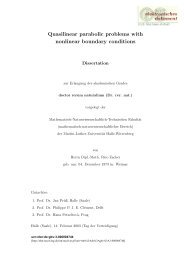Solubilisierung stark lipophiler Arzneistoffe in lipidhaltige ...
Solubilisierung stark lipophiler Arzneistoffe in lipidhaltige ...
Solubilisierung stark lipophiler Arzneistoffe in lipidhaltige ...
Sie wollen auch ein ePaper? Erhöhen Sie die Reichweite Ihrer Titel.
YUMPU macht aus Druck-PDFs automatisch weboptimierte ePaper, die Google liebt.
Summary<br />
carriers. The derived function demonstrated an excellent fitt<strong>in</strong>g to the absorption data<br />
obta<strong>in</strong>ed <strong>in</strong> this work by us<strong>in</strong>g the mentioned permeation model. The obta<strong>in</strong>ed K values<br />
for TP and TE carried by Br35 mixed micellar systems were almost identical, whereas<br />
detected D M for TE was, unexpectedly, significantly smaller as compared with it for TP.<br />
This revealed that besides the <strong>in</strong>creased drug aff<strong>in</strong>ity to the micellar phase, other<br />
important factors are possibly <strong>in</strong>volved <strong>in</strong> this case. The most likely ones are the high<br />
polarity of the hydrated polyoxyethylen layer of Br35 micelles or an <strong>in</strong>terfacial surfactant<br />
boundary layer developed on the membrane surface which may exhibit upon an <strong>in</strong>crease<br />
<strong>in</strong> drug lipophilicity an <strong>in</strong>creas<strong>in</strong>g resistance to drug transfer from the aggregate <strong>in</strong>terior<br />
<strong>in</strong>to the membrane.<br />
Further experiments were conducted us<strong>in</strong>g the Uss<strong>in</strong>g chamber and excised segments<br />
from mice small <strong>in</strong>test<strong>in</strong>e <strong>in</strong> order to study the <strong>in</strong>fluence of drug lipophilicity and used<br />
micellar carriers on drug delivery <strong>in</strong> small <strong>in</strong>test<strong>in</strong>e. The above mentioned rule of<br />
differences <strong>in</strong> drug aff<strong>in</strong>ities proved to be valid here as well, both quantitatively, <strong>in</strong> term<br />
of drug solubilization, and qualitatively, <strong>in</strong> term of strength of drug b<strong>in</strong>d<strong>in</strong>g <strong>in</strong>teractions<br />
with a considered phase. Accord<strong>in</strong>gly, a weak drug delivery was obta<strong>in</strong>ed by us<strong>in</strong>g the<br />
micellar systems of HTAB as drug carriers for testosterone and TP, whereas no delivery<br />
was detected with the more lipophilic esters such as TE. This was simply attributed to<br />
the aforementioned high solubiliz<strong>in</strong>g capacity of those systems toward the studied highly<br />
lipophilic drugs, which naturally <strong>in</strong>creases with lipid addition or <strong>in</strong>creas<strong>in</strong>g drug<br />
lipophilicity. However, other factors were believed to contribute to the reduced drug<br />
delivery here such as the high polarity of the superficial micellar layer, as <strong>in</strong>dicated by the<br />
cybotactic polarity measurements, and the electrostatic repulsion between the positively<br />
charged micelles and membrane surfaces.<br />
In summary, an ideal micellar carrier system for the delivery of highly lipophilic drugs to<br />
a mucosal membrane should demonstrate an almost identical aff<strong>in</strong>ity to the drug as<br />
compared to the epithelial cell membrane, and a rather small hydratation grade or<br />
polarity <strong>in</strong> its superficial layers as well as a possibly neutral or negative surface electric<br />
charge. This may seem contradictory for the development of such systems, s<strong>in</strong>ce one<br />
expects <strong>in</strong> this case from an ideal micellar system to present also a high solubiliz<strong>in</strong>g<br />
capacity for such drugs. Furthermore, the membrane damag<strong>in</strong>g effect known to be<br />
<strong>in</strong>duced by surfactants and <strong>in</strong> particular their micellar systems gives rise to lipid addition<br />
to these systems, based on the known protective or mitigat<strong>in</strong>g role of lipids <strong>in</strong> such<br />
cases. However, this addition leads <strong>in</strong> most cases to an enhancement of the solubilization<br />
of highly lipophilic drugs (<strong>in</strong>creas<strong>in</strong>g drug aff<strong>in</strong>ity to the micelles) and to a possible<br />
<strong>in</strong>crease <strong>in</strong> the hydratation grade of the superficial micellar layers, as seen <strong>in</strong> cases<br />
studied <strong>in</strong> this work. Therefore, the formulation of the mixture should take those factors<br />
also <strong>in</strong>to account and try to f<strong>in</strong>d a compromise between them <strong>in</strong> order to achieve an<br />
optimal drug delivery by means of these carrier systems. Nevertheless, the improvement<br />
of the solubilization of highly lipophilic drugs by us<strong>in</strong>g such lipid-conta<strong>in</strong><strong>in</strong>g mixed<br />
micellar systems as drug carriers rema<strong>in</strong>s beneficial and particularly attractive under<br />
many aspects and as long as the drug <strong>in</strong>clusion with<strong>in</strong> the micelles does not lead to a<br />
strong h<strong>in</strong>drance of the drug delivery to the membranes. One of the most important<br />
reasons is that these systems enable highly lipophilic drugs to overcome the mucus<br />
layer, one of the most crucial barriers to their transport to the epithelial cell membrane <strong>in</strong><br />
the gastro<strong>in</strong>test<strong>in</strong>al tract. Furthermore, these Systems usually help to solubilize such<br />
drugs <strong>in</strong> sufficient amounts and to improve drug dissolution rate, which could be <strong>in</strong><br />
many <strong>in</strong>stances, and particularly here <strong>in</strong> the case of such drugs, the rate limit<strong>in</strong>g step for<br />
drug transport, thereby lead<strong>in</strong>g f<strong>in</strong>ally to a substantial improvement of drug absorption.<br />
106










